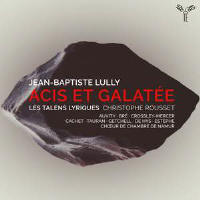Texte paru dans: / Appeared in: |
|
|
Outil de traduction |
|
|
The Ovidian plot will be familiar to many from Handel’s popular setting: shepherd Acis loves sea-nymph Galatea, but so does monstrous cyclops Polyphemus, who jealously eliminates Acis by crushing him under a rock. Galatea appeals to Neptune to bring Acis back to life, which he does by transforming him into a river. Lully’s librettist adds a parallel story of the love of shepherd Telemus for Galatea’s companion Scylla (firmly unrequited) and throws in some feisty initial resistance on Galatea’s part for good measure. Lully called it a pastorale héroïque, and compared to tragédie it is lighter in tone, slimmer in plot and shorter on acts – only three following the allegorical prologue instead of the usual five. Its musico-dramatic tools are the same, however, and Lully is not afraid to use them to show its situations, conflicts and emotions with similar artistic integrity and seriousness. Highlights alongside the customarily effective layout of dances and choruses include a finely judged dialogue for the lovers in which Galatea’s ice finally melts, and a touching air en chaconne for her to inwardly celebrate their union, only to be interrupted by the approach of Polyphemus with his clumping drums and tootling flutes. In the final act, Galatea’s dignified lament for Acis explores her lapping shades of grief and realisation with great sensitivity and resource, and there is a concluding passacaille which, at nearly 14 minutes, must be one of the most sustained single movements in 17th-century music. Christophe Rousset and Les Talens Lyriques are old hands at Lully’s stage works – this is their 10th – and sound stylistically spot on. The orchestra is warm and caressing, the choir clear and agile, and Rousset draws lovely timbre and line from them throughout. Cyril Auvity’s delicate haute-contre gives Acis a fitting sense of vulnerability, and as Galatea Ambroisine Bré’s combination of tonal depth and hard sheen bring edge to her disdain and power to her mourning. Edwin Crossley-Mercer is suitably hot-headed as Polyphemus, though without straying too far into comedy, even if the murderously rolled boulder does sound like the kind of thing Indiana Jones used to run from. In truth, poor old Polyphemus is a rather ill-used character, and Lully’s exposition of him is non-judgemental. Bénédicte Tauran as Scylla and Robert Getchell as Telemus both perform well, though a less than fully attentive listener may find it sometimes hard to distinguish them from the principals. In this respect the 1996 Marc Minkowski recording with a cast led by Véronique Gens, Jean-Paul Fouchécourt and Laurent Naouri (Archiv, A/98) is better defined, but while the drama there may be more sharply drawn, its text declamation can sometimes seem a touch rigid. Although there is little to choose between these two recordings, perhaps the greater beauty and stylistic assurance of the Rousset just carries the day.
|
|




